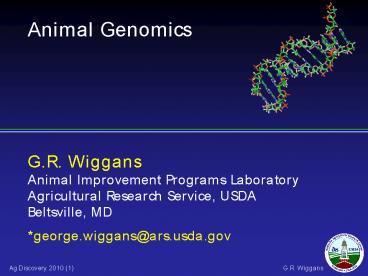Animal Genomics - PowerPoint PPT Presentation
Title:
Animal Genomics
Description:
Animal Genomics Goals of animal scientists Increase efficiency of food production Learn how animals work Improve resistance to disease Improve adaptation of animal ... – PowerPoint PPT presentation
Number of Views:75
Avg rating:3.0/5.0
Title: Animal Genomics
1
Animal Genomics
2
Goals of animal scientists
- Increase efficiency of food production
- Learn how animals work
- Improve resistance to disease
- Improve adaptation of animal products to human
needs
3
What is genomics
- Study of how the genome (DNA) of any species is
organized and expressed as traits - New technologies allow examination of the genome
of an organism as a whole, rather than one gene
at a time - Livestock and poultry genomes sequenced to
understand how various genes function (functional
genomics)
4
Federal support for genomics in
- Cattle
- Sheep
- Swine
- Poultry
- Horses
- Aquaculture (fish and other water animal)
5
How do we use genomics
- Identify DNA sequences associated with disease
resistance and production traits. - Animals can be evaluated as soon as DNA can be
taken (even before birth) - Best animals to be parents can be determined
earlier and more accurately
6
Dairy cattle selection before
- Slow!
- Progeny testing for production traits takes 3 to
4 years from insemination - A bull will be at least 5 years old before his
first evaluation is available - Expensive!
- Progeny testing costs 25,000 - 50,000 per bull
- Only 1 in 8 to 10 bulls graduate from progeny
test - At least 200,000 invested in each active bull!!
7
Bovine Genome Sequence
8
Background Genetic Markers
- A segment of DNA at a unique physical location in
the genome that varies sufficiently between
individuals that its inheritance can be tracked
through families. - A marker is not required to be part of a gene.
9
Genetic Markers
- Allow inheritance to be followed in a region
across generations - Single nucleotide polymorphisms (SNP) are the
markers of choice - Need lots!
- 3 million in the genome
10
Cattle SNP Collaboration - iBMAC
- Develop 60,000 Bead Illumina iSelect assay
- USDA-ARS Beltsville Agricultural Research Center
Bovine Functional Genomics Laboratory and Animal
Improvement Programs Laboratory - University of Missouri
- University of Alberta
- USDA-ARS US Meat Animal Research Center
- Starting 60,800 beads 54,000 useable SNP
11
(No Transcript)
12
Participants
iBMAC Consortium
Funding Agencies
- Illumina
- Marylinn Munson
- Cindy Lawley
- Christian Haudenschild
- BARC
- Curt Van Tassell
- Lakshmi Matukumalli
- Tad Sonstegard
- Missouri
- Jerry Taylor
- Bob Schnabel
- Stephanie McKay
- Alberta
- Steve Moore
- USMARC Clay Center
- Tim Smith
- Mark Allan
- USDA/NRI/CSREES
- 2006-35616-16697
- 2006-35205-16888
- 2006-35205-16701
- USDA/ARS
- 1265-31000-081D
- 1265-31000-090D
- 5438-31000-073D
- Merial
- Stewart Bauck
- NAAB
- Godon Doak
- ABS Global
- Accelerated Genetics
- Alta Genetics
- CRI/Genex
12
13
Genomic evaluation - dairy cattle
- Cooperating organizations
- Breed associations
- Holstein
- Jersey
- Brown Swiss
- Bull studs
- Own bulls
- Collect and market semen
- Full sharing of genotypes and research with
Canada - Trading of genotypes with Switzerland
- Expect to share with more countries
- Over 50,000 animals genotyped starting in 2008
14
How is it done?
- Animals selected
- Studs identify male and female calves to genotype
- Farmers request breed association to arrange for
genotyping - Animal nominated at AIPL insures that pedigree
information is in database - Sample sent to lab
- Hair follicles (most common)
- Blood
- Semen
- Nasal swab
15
Lab work
- Extract DNA
- Incorporate DNA into reagents on chip (3 days)
- Laser scanner collects intensity data
- GenomeStudio software assigns genotype after
clustering intensities
16
What is done at AIPL
- Genotypes checked
- Sex
- Breed
- Parents
- Duplicate of another animal
- 90 of SNP genotyped
- Requesters notified of conflicts
- For parent conflicts, alternative parents usually
suggested - Parentage and sample ID Corrected
- Genotypes extracted
- Genotypes for gt2000 dams figured out from their
progeny (imputation)
17
Traits evaluated
- Milk yield
- Fat in milk
- Protein in milk
- Resistance to udder infection
- Fertility
- Length of productive life
- Difficulty having a calf
- Likelihood of calf being alive 2 days after birth
- 18 traits describing the cows appearance such as
stature
18
Genotyped Holsteins
Date Young animals Young animals All animals
Date Bulls Cows Bulls Heifers All animals
04-09 7,600 2,711 9,690 1,943 21,944
01-10 8,974 4,348 14,061 6,031 33,414
02-10 9,378 5,086 15,328 7,620 37,412
04-10 9,770 7,415 16,007 8,630 41,822
05-10 9,958 7,940 16,594 9,772 44,264
06-10 9,958 8,122 17,507 10,713 46,300
07-10 9,963 8,186 18,187 11,309 47,645
Traditional evaluation No traditional
evaluation
19
Summary
- Genomics is revolutionizing animal breeding
- Genomic selection is used extensively in dairy
cattle breeding - High quality genotypes support detection of
parentage and other errors - International collaboration has been important to
the success
20
(No Transcript)































